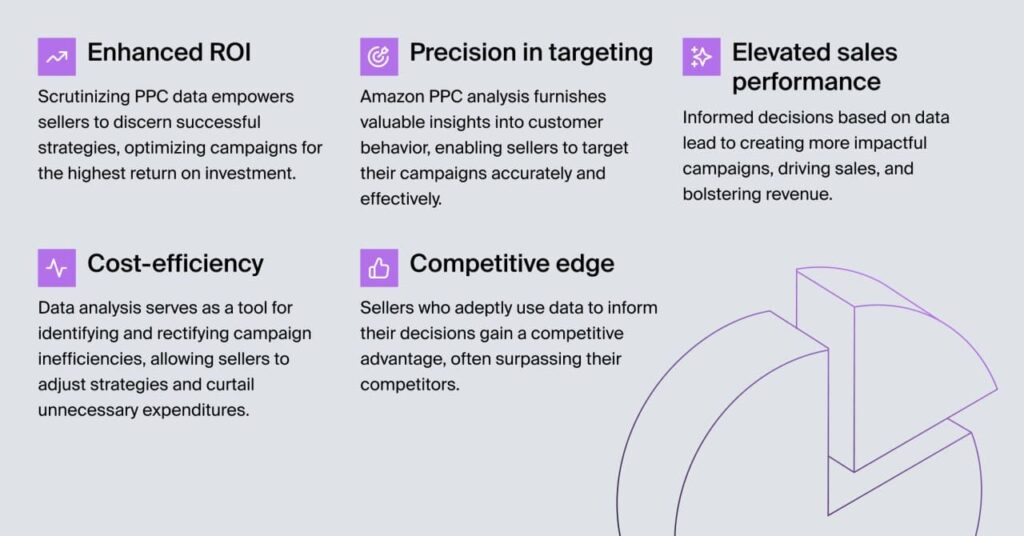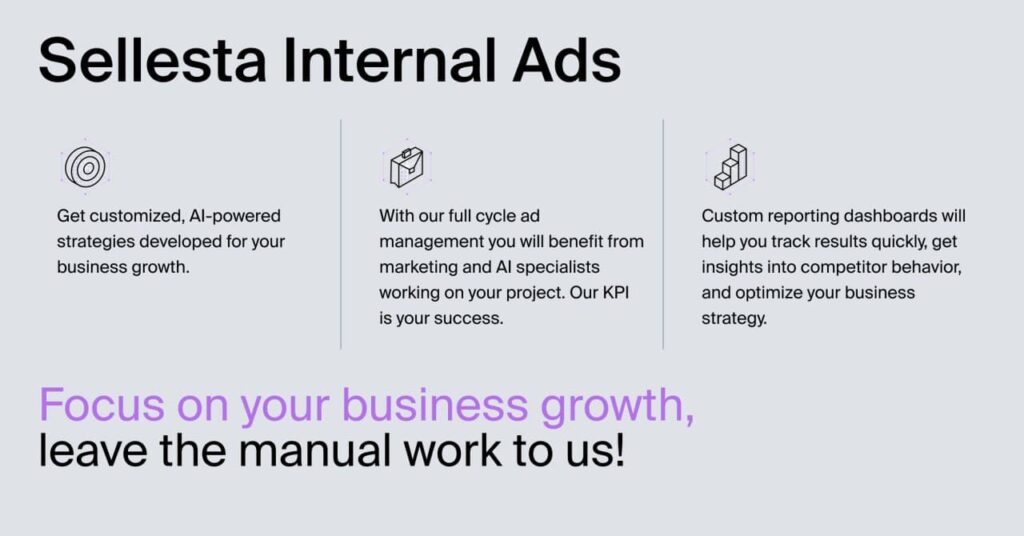
Elevating the performance of your Amazon PPC campaigns is a pursuit of precision. Diving into data is essential in optimizing your advertising budget. It can help you discover multiple opportunities to save money, increase your click through rate, and grow sales.
For those seeking guidance on Amazon PPC analysis or aiming to refine their campaign strategy, the following tips and insights will widen your understanding of analytics through different metrics and platforms, and fortify your presence on the platform.
Table of Contents
Benefits of data-driven decision-making in PPC campaigns
Leveraging data for decision-making in PPC campaigns presents numerous advantages for sellers.

Define goals and examine trends
Establishing clear campaign goals is paramount before immersing yourself in Amazon PPC data. Whether the objective is to boost sales, grow conversion rates, launch a new product, or enhance brand visibility, well-defined goals are the foundation for strategic decision-making.
Besides looking forward to your goals, it’s vital to look back. Unlocking the full potential of future Amazon PPC campaigns needs a comprehensive understanding of historical trends and cycles. This is particularly critical when dealing with seasonal data (for example, a campaign for Q4, which encompasses Black Friday and Christmas). Utilizing trend analysis tools within Amazon allows you to identify patterns, empowering strategic planning to maximize the impact of upcoming PPC campaigns. Insight into the interplay of various Amazon Key Performance Indicators (KPIs) further facilitates resource-efficient spending.
Monitor critical metrics
Depending on your campaign goals, there are several KPIs you can include in your Amazon PPC analysis. Here are the most common metrics ecommerce businesses like to monitor:
1. Impressions: The number of times an Amazon shopper sees your ad. Vigilantly tracking impressions offers insights into your ad’s visibility and the potential reach of your campaign.
2. Clicks: The instances when a shopper engages with your ad. This metric gauges your ad’s effectiveness and ability to drive traffic to your product listing.
3. Click-Through Rate (CTR): The ratio of clicks to impressions quantifies the percentage of shoppers who click on your ad. A higher CTR indicates greater relevance to your target audience. It’s important to note that a good CTR is not a guarantee for success: if users land on a page that doesn’t match what they saw on the ad, they will immediately leave your website.
4. Cost-Per-Click (CPC): The cost incurred for each click on your ad. Monitoring CPC helps understand your keywords’ competitiveness and your bidding strategy’s efficiency.
5. Spend: The total monetary outlay on your campaign. Observing spending patterns ensures adherence to budget constraints and facilitates optimization for a better return on investment (ROI).
6. Sales: The number of units sold through your ad. This metric is pivotal in gauging the effectiveness of your campaign in driving sales and generating revenue.
7. Advertising Cost of Sales (ACoS): The ratio of ad spend to sales, offering insights into the efficiency of your advertising expenditure and the resultant profit margin.
8. Conversion rate: The percentage of users who take a desired action after interacting with an advertisement or website. Conversion examples can be from browsing to shopping cart or from shopping cart to purchase.
9.Return on ad spend (ROAS): The ratio of revenue generated to ad spend, serves as a key metric to understand the profitability of your advertising efforts, revealing the revenue generated for every dollar invested in ads.
Navigate diverse Amazon reports
KPIs are very useful, but they don’t work in isolation. You’ll need an integrated vision to help you read further into the data to make decisions.
Amazon offers a suite of reporting tools tailored to diverse PPC campaign structures, ranging from sponsored products to display ads. These tools encompass a spectrum of analytics, including customer search terms, clicks, click-through rates, and page impressions. Amazon Seller Central serves as a centralized hub for accessing specific data relevant to the nuances of your analysis.
Essential Amazon reports
Amidst the myriad of Amazon advertising reporting tools, a focus on critical reports can streamline your efforts:
1. Search term report: Aligns customer search terms with PPC keywords for a refined keyword list.
2. Placement report: Provides comprehensive data on ad placements, facilitating bid adjustments and optimizing product visibility.
3. Advertised products report: Offers insights into the performance of advertised ASINs, excluding data on other purchased products.
4. Targeting report: Presents data on the overall performance of targets, covering keywords, products, categories, or brands over a 90-day period.
5. Purchased product report: Details performance metrics of advertised ASINs not specifically targeted, uncovering new leads and opportunities.
Beyond the mere reports, creating actionable insights for future PPC campaigns is vital. Given Amazon’s dynamic nature, staying abreast of changes to the advertising platform is imperative. Amazon reports highlight successful strategies and areas for improvement. They also provide invaluable insights into consumer behavior. Leveraging reports for effective keyword research, identifying negative keywords, and informing choices regarding keyword match types is paramount.
Other tools for Amazon PPC enhancement
Several tools, including the Amazon Advertising console, Google Analytics, and third-party analytics solutions, serve as powerful assets for sellers aiming to refine their Amazon PPC campaigns. Although Amazon’s console provides valuable insights, other tools can help broaden what you know about your buyers.
As we learned in the previous section, the Amazon Advertising console provides tailored data and reports specifically designed for Amazon PPC campaigns. This is why it always stands out as a favorite for sellers.
In tandem with the Amazon Advertising console, Google Analytics is a robust tool for delving into Amazon PPC data. Sellers can utilize it to monitor website traffic, track conversions, and gauge the efficacy of their advertising endeavors. Integrating Google Analytics with Amazon PPC campaigns elevates the analytical scope, providing sellers with a holistic understanding of how their ads impact website traffic and sales.
Beyond these platforms, third-party solutions like Sellesta Internal Ads combine the adavantages of AI and a full cycle ads management led by a human team. Sellesta goes beyond basic metrics, incorporating automation features such as automated bid adjustments and innovative keyword research tools. Its functionality equips sellers with the means to optimize campaigns strategically, ultimately enhancing their return on investment (ROI).

Analyze or miss the train
Data analysis is your Amazon PPC campaigns’ only possible road to success. Sellers need to monitor regularly to identify trends, patterns, and improvement opportunities.
Leveraging popular tools like Amazon Advertising Console, Google Analytics, and third-party analytic tools can make a real difference in enhancing campaign performance faster and easier.
Sellesta Internal Ads, our AI-driven solution, is tailored so you reach peak performance in your Amazon advertising journey. With full AI capabilities, our full-cycle ad management boosts the right KPIs on your Amazon advertising campaigns to increase your revenue.
Test the waters with our free demo and amplify your Amazon advertising strategy today!


